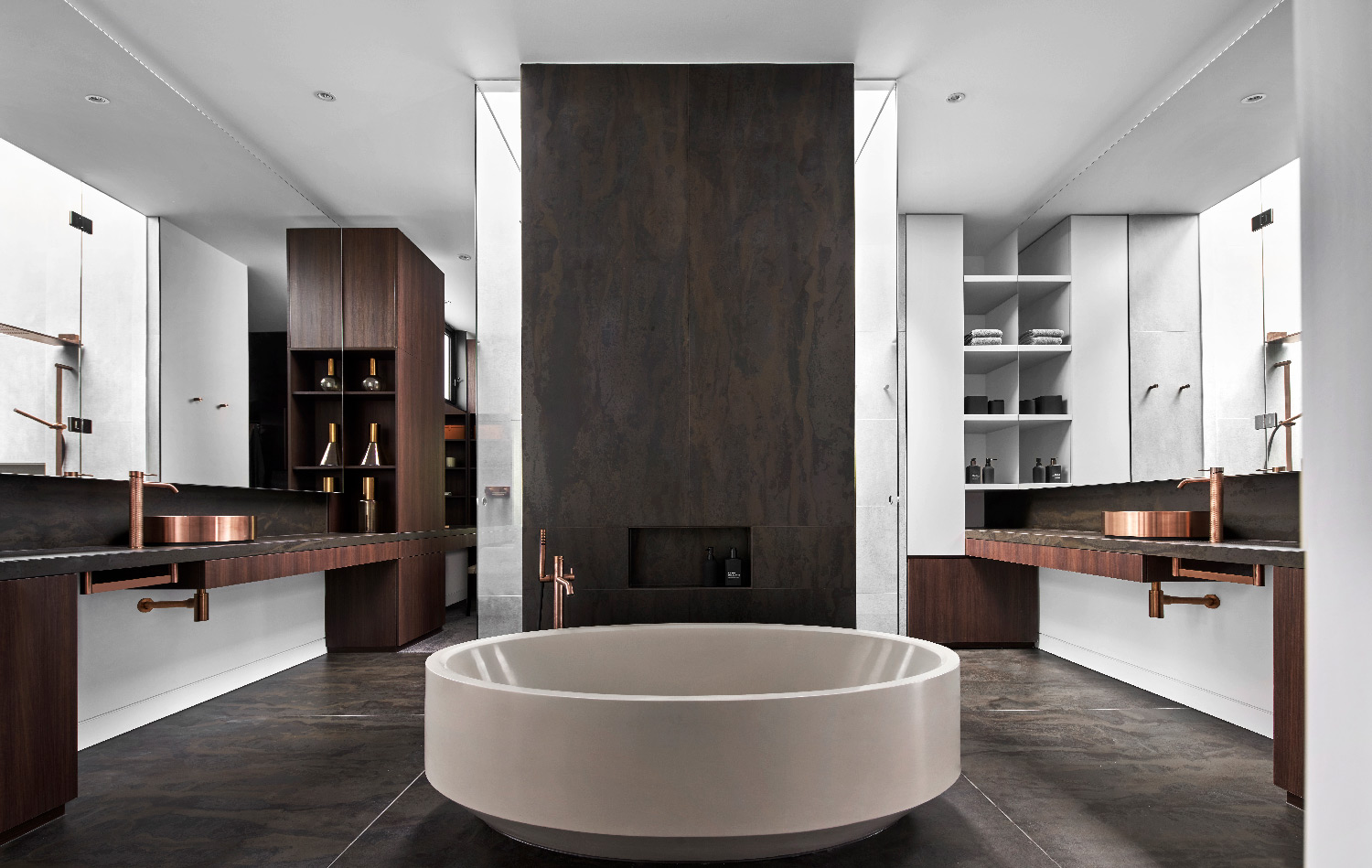BLURRING THE LINES – Taking the bath out of the bath ‘room’
 LEFT: Using the bath as a focal point, this space blurs the line between outside and inside in the lovely courtyard of this Melbourne residence. RIGHT: Tucked into a narrow nook in the attic, this bath transforms the space into a beautiful wet room.
If we go back to the history of bathing for just a moment, before modern plumbing, a bath would be either hand carried into a kitchen near the fire, or placed in one’s private sleeping quarters, or even in a tub in the garden.
Now take a moment to consider the present-day bathtub. It is the largest item in the bathroom, is ergonomically designed and its function is to provide a comfortable place in which to cleanse, relax and revitalise. Perhaps it’s a favourite place to read a great novel, enjoy a glass of wine at the day’s end, or admire a beautiful view. If you consider the bath from this perspective – really, it’s more like a chaise lounge or window seat with the joyful addition of water!
It might be slightly unconventional – but does the bath need to be hidden away in the bathroom?
If you have a fondness for the outdoors, why not place the bath in a secluded courtyard. If space is your challenge, perhaps in a sunny spot on a landing or in a converted loft space would work perfectly.
We love baths placed in spaces which defy the idea that bathing should only be done in a purpose-built bathroom, and spaces that blur the lines between bathing, living, dressing and sleeping.
LEFT: Using the bath as a focal point, this space blurs the line between outside and inside in the lovely courtyard of this Melbourne residence. RIGHT: Tucked into a narrow nook in the attic, this bath transforms the space into a beautiful wet room.
If we go back to the history of bathing for just a moment, before modern plumbing, a bath would be either hand carried into a kitchen near the fire, or placed in one’s private sleeping quarters, or even in a tub in the garden.
Now take a moment to consider the present-day bathtub. It is the largest item in the bathroom, is ergonomically designed and its function is to provide a comfortable place in which to cleanse, relax and revitalise. Perhaps it’s a favourite place to read a great novel, enjoy a glass of wine at the day’s end, or admire a beautiful view. If you consider the bath from this perspective – really, it’s more like a chaise lounge or window seat with the joyful addition of water!
It might be slightly unconventional – but does the bath need to be hidden away in the bathroom?
If you have a fondness for the outdoors, why not place the bath in a secluded courtyard. If space is your challenge, perhaps in a sunny spot on a landing or in a converted loft space would work perfectly.
We love baths placed in spaces which defy the idea that bathing should only be done in a purpose-built bathroom, and spaces that blur the lines between bathing, living, dressing and sleeping.
 Designed by Marcus Browne Architect, this residence in Perth is a celebration of raw materials and unconventional spaces. A timber and concrete lightwell create a dramatic stage for the Haven Bath in Charcoal.
Designed by Marcus Browne Architect, this residence in Perth is a celebration of raw materials and unconventional spaces. A timber and concrete lightwell create a dramatic stage for the Haven Bath in Charcoal.
REMOVING THE BOUNDARIES - Bathrooms with nothing to hide
 This huge, custom designed bath at the Jackalope Hotel creates a divide between bathroom and living/sleeping spaces.
When we start planning the layout of a space, we begin by positioning walls and doors in order to form boundaries between areas with a defined purpose. Walls provide barriers, hide contents, provide privacy and create intimacy.
Our daily cleansing rituals are personal, vulnerable and intimate moments, so we create secluded, private spaces for bathing. But is this an outdated idea? By definition - intimacy is closeness, affection and familiarity shared with another person. It is about allowing oneself to be vulnerable, sharing private thoughts and moments, being open and having nothing to hide.
Grand master bedrooms or retreats which merge sitting, sleeping and dressing have become relatively common. But we are seeing more and more spaces challenging the idea that the ensuite should be hidden from view.
There are some compelling reasons to open the ensuite. More natural light in the bathroom, a sense of spaciousness, showcasing beautiful bathware, or perhaps allowing you to enjoy a beautiful view. If completely open is not your style, switchable glass walls, or curtains will provide that little extra privacy when needed.
This huge, custom designed bath at the Jackalope Hotel creates a divide between bathroom and living/sleeping spaces.
When we start planning the layout of a space, we begin by positioning walls and doors in order to form boundaries between areas with a defined purpose. Walls provide barriers, hide contents, provide privacy and create intimacy.
Our daily cleansing rituals are personal, vulnerable and intimate moments, so we create secluded, private spaces for bathing. But is this an outdated idea? By definition - intimacy is closeness, affection and familiarity shared with another person. It is about allowing oneself to be vulnerable, sharing private thoughts and moments, being open and having nothing to hide.
Grand master bedrooms or retreats which merge sitting, sleeping and dressing have become relatively common. But we are seeing more and more spaces challenging the idea that the ensuite should be hidden from view.
There are some compelling reasons to open the ensuite. More natural light in the bathroom, a sense of spaciousness, showcasing beautiful bathware, or perhaps allowing you to enjoy a beautiful view. If completely open is not your style, switchable glass walls, or curtains will provide that little extra privacy when needed.
 TOP: Glass walls furnished with curtains provide a little privacy for the Piccolo bath in the master bedroom at Elwood House. LEFT: Zen Bath and Basins showcased in this open ensuite at the Jewel Residences. RIGHT: The Reflection Bath at Cranim Resort, Tel Aviv.
TOP: Glass walls furnished with curtains provide a little privacy for the Piccolo bath in the master bedroom at Elwood House. LEFT: Zen Bath and Basins showcased in this open ensuite at the Jewel Residences. RIGHT: The Reflection Bath at Cranim Resort, Tel Aviv.
 Black framed glass separates the bathroom from the bedroom allowing the Sublime bath and basins to be admired.
Black framed glass separates the bathroom from the bedroom allowing the Sublime bath and basins to be admired.
A CONSIDERED STATEMENT – Placement matters
 TOP: The Zen Round Bath sits centre-stage in this expansive bathroom of J House in Melbourne. BOTTOM: The Oman Bath is showcased on a marble stage at Residence R in Sydney, Australia.
TOP: The Zen Round Bath sits centre-stage in this expansive bathroom of J House in Melbourne. BOTTOM: The Oman Bath is showcased on a marble stage at Residence R in Sydney, Australia.
 When arranging our living areas, we consider the placement of furniture to create points of interest in a space or invest in a statement piece which becomes the central focus of the room. So why don’t we always take the same care in arranging our bathrooms?
A gorgeous freestanding bath acts as a centrepiece in the bathroom, anchoring the entire space and often defining the rest of the design. Therefore, placement is crucial. Some baths need room to allow the design to be appreciated. Others look beautiful tucked into a nook, or in front of a window to give the illusion of space. Regardless of the bath's design, the positioning can make a space more dynamic, feel bigger, flow better and reinforce style.
If you are installing a freestanding bath, make sure it is a considered statement. Contemplate placing it in the centre of the room, or on an elevated ‘stage’ (also great for hiding difficult plumbing conditions), or even positioning it on an angle for a more unusual arrangement.
When arranging our living areas, we consider the placement of furniture to create points of interest in a space or invest in a statement piece which becomes the central focus of the room. So why don’t we always take the same care in arranging our bathrooms?
A gorgeous freestanding bath acts as a centrepiece in the bathroom, anchoring the entire space and often defining the rest of the design. Therefore, placement is crucial. Some baths need room to allow the design to be appreciated. Others look beautiful tucked into a nook, or in front of a window to give the illusion of space. Regardless of the bath's design, the positioning can make a space more dynamic, feel bigger, flow better and reinforce style.
If you are installing a freestanding bath, make sure it is a considered statement. Contemplate placing it in the centre of the room, or on an elevated ‘stage’ (also great for hiding difficult plumbing conditions), or even positioning it on an angle for a more unusual arrangement.
 The Swatch Art Peace Hotel illustrates that an asymmetrical shape, or bath placed at the perfect angle brings dynamism to the space.
The Swatch Art Peace Hotel illustrates that an asymmetrical shape, or bath placed at the perfect angle brings dynamism to the space.
REDEFINING ROLES – Multifunctional bathware
For many of us, limited space can mean compromise when it comes to designing our bathrooms. But why can’t bathware be multifunctional? Installing a shower over a bath is not a new concept. However, the traditional set up is dated and not as luxurious as a walk-in shower, or beautiful soaking bath. The good news is, the ‘shower bath’ is enjoying a resurgence driven by clever designs which merge the best of both. The Sampan shower bath combines style and functionality. Inspired by shallow Japanese reflective pools the low profile reduces water consumption, is safer and makes it a great family bath. Yet, its generous footprint gives the illusion of a large shower and the recline of the bath provides an experience reminiscent of floating. Similarly, your vanity can be designed with more than one purpose in mind. A long, integrated vanity with off-set basin could transition from vanity to dressing room. It might extend into the shower creating a perfect shelf for product. In a hotel, it could morph into the mini bar, or even a workspace. LEFT: The Sampan Shower Bath. RIGHT: A custom vanity created for The Arlo Nomad Hotel in New York.
LEFT: The Sampan Shower Bath. RIGHT: A custom vanity created for The Arlo Nomad Hotel in New York.
THE ILLUSIONISTS - Designing bathrooms as…rooms
 The Haven bath at Twig House in Melbourne looks like it has been placed in a spa. Designed by Leeton Pointon Architects and Allison Pye Interiors.
The Haven bath at Twig House in Melbourne looks like it has been placed in a spa. Designed by Leeton Pointon Architects and Allison Pye Interiors.
We talk about designing sanctuaries rather than purely functional bathrooms quite a lot. But this typically means our approach to materiality, bringing the outdoors in and creating atmospheric, not sterile spaces. With performance advancements in a greater range of building materials and fabrics, what about the notion of designing a ‘room’ in the more traditional sense - which can also be used for bathing?
Whilst there are some practical considerations such as waterproofing, plumbing and water-resistant materials, there is something truly indulgent in the idea of creating a bathing space which feels more like a serene spa.
To create the illusion, consider adding fabrics and curtains, or placing a beautiful rug to create a cosy atmosphere which is more dressing room than bathroom. Use furniture and statement lighting for a space that is more private living than ‘bathing’.
 The addition of curtains makes this space feel more like a cosy living room. Pictured: Zen Oval Bath at Hawksburn House, Melbourne.
The addition of curtains makes this space feel more like a cosy living room. Pictured: Zen Oval Bath at Hawksburn House, Melbourne.
 Designed by Patrick Meneguzzi, this powder room is more boudoir than bathroom. Pictured: Sublime Petit Basin in Graphite at City House, Caulfield North.
Designed by Patrick Meneguzzi, this powder room is more boudoir than bathroom. Pictured: Sublime Petit Basin in Graphite at City House, Caulfield North.
 The placement of armchairs transforms this space into a bathing lounge. Pictured: The Haven Bath at Cheval Blanc Resort, Maldives.
The placement of armchairs transforms this space into a bathing lounge. Pictured: The Haven Bath at Cheval Blanc Resort, Maldives.
THE HUMAN ELEMENT – Embracing touch
In this digital age, where human connection is disrupted by ubiquitous technology and we are constantly striving for perfection – are we craving a different sensory experience? Back to the notion of ‘wellness’… Increasingly we see an awareness in how our built environment plays a role in our sense of wellbeing. Not a new concept, but it seems to have driven a move toward enhanced tactility and natural materiality in our interiors. LEFT: This bathroom in Singapore showcases the beauty of raw, honest materials - stone, concrete and recycled wood. Pictured: Lunar Bath and Basins in a private residence in Singapore. RIGHT: Eclipse Basins in a private residence in Brisbane.
Whether it is textured upholstery, hand-made tiles, linens, timber or stone, we surround ourselves with things we can touch and feel, making us feel more present and grounded. The bathroom may have been one of the last to embrace this change, but happily we are now creating spaces which allow us to stimulate our senses and elevate our cleansing rituals.
Take inspiration from nature when designing your tactile bathroom. Select natural materials, layer textures and neutral colours, and consider the quality of light to create a grounding and restful space.
LEFT: This bathroom in Singapore showcases the beauty of raw, honest materials - stone, concrete and recycled wood. Pictured: Lunar Bath and Basins in a private residence in Singapore. RIGHT: Eclipse Basins in a private residence in Brisbane.
Whether it is textured upholstery, hand-made tiles, linens, timber or stone, we surround ourselves with things we can touch and feel, making us feel more present and grounded. The bathroom may have been one of the last to embrace this change, but happily we are now creating spaces which allow us to stimulate our senses and elevate our cleansing rituals.
Take inspiration from nature when designing your tactile bathroom. Select natural materials, layer textures and neutral colours, and consider the quality of light to create a grounding and restful space.
 A delicate balance and play of textures and finishes adds tactility to this private residence in Melbourne. Pictured: Lotus Bath and Basins.
A delicate balance and play of textures and finishes adds tactility to this private residence in Melbourne. Pictured: Lotus Bath and Basins.
COLOUR THEORY – The end of monochrome?
Not really. Beautifully crafted, monochromatic black and white bathrooms will always be a favourite. Likewise, carefully layered neutral palettes are timeless and create a tranquil atmosphere. Beautiful handmade tiles add colour and life to the space. LEFT: Kawakawa House, New Zealand; RIGHT: Chi Basin at Byron Bay Villa in New South Wales by The Designory.
But why not surround yourself with colour? We all know colour can impact our mood, promote healing and lift our general sense of wellbeing. Lately, colour seems to be making an appearance in bathrooms again. There is plenty of inspiration around right now, find a colour you love and go for it!
Beautiful handmade tiles add colour and life to the space. LEFT: Kawakawa House, New Zealand; RIGHT: Chi Basin at Byron Bay Villa in New South Wales by The Designory.
But why not surround yourself with colour? We all know colour can impact our mood, promote healing and lift our general sense of wellbeing. Lately, colour seems to be making an appearance in bathrooms again. There is plenty of inspiration around right now, find a colour you love and go for it!
 Find out more about our creative process of Bath Couture, connect with our global project teams or book an individual appointment with our consultants in the Melbourne and Singapore showroom.
Find out more about our creative process of Bath Couture, connect with our global project teams or book an individual appointment with our consultants in the Melbourne and Singapore showroom.




